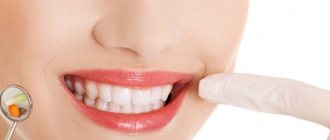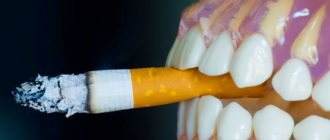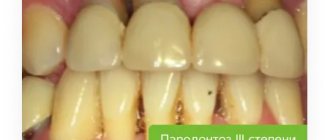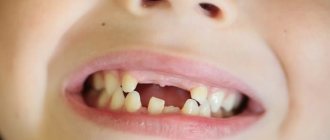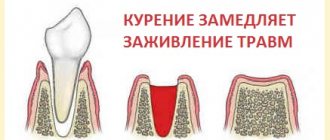When is it necessary to remove a tooth root?
In all cases, the doctor decides individually whether the situation requires tooth root removal after carrying out diagnostic measures and examination using radiography or visiography. Among the most common indications for tooth root removal are the following:
- the patient suffers from aching and throbbing pain in the tooth;
- in the peri-root area there is some swelling of the gums;
- there are signs of inflammation;
- the root of the tooth is destroyed;
- third degree of tooth root mobility;
- tooth fracture is of increased complexity;
- the level at which the destruction of the dental crown is located is located below the level of the gums;
- a cyst was diagnosed.
If the rotting tooth root is not removed in a timely manner, it can give rise to a serious infectious process in the oral cavity, as well as bad breath. Problems will certainly affect healthy tissues nearby.
In some cases, even in the presence of inflammation and severe tooth decay, you can do without root removal. This will allow, after carrying out the necessary therapeutic measures, to restore or build up the tooth. The final decision on this issue is made by the dentist.
What to do if a dead tooth breaks at the root?
“Doctor, I was just chewing a soft bun when I felt something crunch.” This is how the patient’s story usually begins about how it happened that some strange stump was left from the tooth. Is it possible to “save” the tooth from removal in such cases? What criteria does the dentist use in such cases? Finally, how exactly to properly restore a tooth in such situations - fill it with a filling, put a crown, “strengthen it with a pin” or something else? We'll talk about this today.
First, just a little theory. Why do dead teeth break so often ? By creating access to the root canals, the doctor removes quite a lot of tissue. In this case, as a rule, the need for root canal treatment is caused by advanced caries, which by the time of treatment has already “eaten” part of the tooth. As a result of these two reasons, after root canal treatment, the patient receives a severely weakened tooth. Some walls may be completely absent, some will be greatly thinned. Imagine an unopened can of cola... or beer (whichever is closer). Try to break it with your hands. This will not be easy to do. Now open it, drink the contents and you will get a model of the tooth with the insides removed and thin walls. You don’t have to be a beefy bodybuilder to be able to easily crush it with your hands. Much the same thing happens with dead teeth. Fragile walls cannot withstand large and constantly repeated cyclic loads during chewing. Our masticatory muscles can develop a force of up to 400 kg cm2. Imagine that such a 400-kilogram young man is riding on your tooth every day.
At the same time, it doesn’t matter at all what you eat: crackers, nuts or fresh bread. Sooner or later, the weakened walls of the tooth will crack. And this result is inevitable.
What to do if a tooth is broken? Should I delete it? Or can it be restored? And, if possible, how to do it better? The main criterion by which the doctor decides on the advisability of preserving the “hemp” is the quantity and quality of hard tissues rising above the gum. Ideally, it should be like this: the edges of the tooth along the entire perimeter are above the level of the gum, the height of the walls is at least 2-3 mm, the thickness is at least 1-2 mm.
Moreover, the higher and thicker the walls, the better the prognosis for restoration. If the tooth wall is chipped deep under the gum, then such teeth often have to be removed. Because no design with a good prognosis can be made for such teeth. If we neglect this rule, then in the very foreseeable future we will get something like this...
...the crown is in the hands, not in the mouth. Any filling, crown, whatever... will not last long on such a root. The main reason for this is that somewhere down there, in the depths of the gums, it is impossible to achieve a perfect fit of any material to the tooth. Any restoration, if done anyway, will begin to “leak” quite quickly under such conditions. This means that the infection living in the oral cavity will easily penetrate into the tooth, “undermining” the tooth from the inside. Therefore, it will be much more reliable to replace such a root with an implant. Of course, you can always find a compassionate dentist-plasterer who will stick something on, apply some grease and at the same time sleep peacefully. But if we are talking about quality and durability, then such options are not for us.
What then for us? Here are some possible correct options for restoring severely damaged dead teeth.
Restoring the tooth stump with a filling + crown.
For example, as in this clinical case. In such cases, a special composite material or amalgam is used to recreate the base of the tooth*
Restoration of the tooth stump with a filling on a fiberglass pin + crown.
Everything is the same, but the filling material is “strengthened” with a pin. This is usually done when there is very little tooth tissue and there is no particular hope for them.
There are many opinions on the advisability of “pinning” teeth, and even among dentists there is no unity on this topic. Some people put pins in all their teeth in a row, others don’t do them at all. The truth, as always, is somewhere in the middle. One thing is for sure - the use of the so-called. anchor metal pins (similar to small screws) today are bad manners.
Stump tab + crown.
In this case, the base for the crown is made in a dental laboratory and is a monolithic structure glued inside the canal. Stump inlays today can be made of metals (cobalt-chromium and gold-platinum alloys) or zirconium dioxide.
These are the main methods for restoring a tooth if it is broken. Each dentist makes the choice between them at his own discretion. The only thing you need to remember: any technique that involves installing a pin in the root canal requires their ideal treatment, because there will be no repeat relatively easy access to them. Therefore, any treatment with pins is in fact the last for the tooth, after which most often only removal is possible. For this and some other reasons, today there is a tendency to move away from the manufacture of any pin structures, especially stump inlays.
So now you know how and what is the best way to restore broken dead teeth.
Tooth root removal: painful or not?
Most often, the situation in which tooth root removal is indicated occurs when the pulp is dead. To avoid pain and discomfort, the “Optimal Choice” dental clinics use modern high-quality local anesthesia before tooth root removal and other manipulations. Therefore, you should not be afraid of pain and put off visiting the dentist for the indefinite future. Today the procedure takes place with a minimum of discomfort.
Indications for surgery
Today, dentists prefer tooth-preserving operations. Therefore, even if there is only one root left, they first study whether it can be used as a basis for future prosthetics. However, in medical practice there are often situations when the removal of a decayed tooth must be carried out without fail.
This is possible if:
the tooth base has become very loose due to advanced periodontitis;- fracture diagnosed;
- a cyst has been discovered that cannot be removed in isolation;
- a fragment of the crown that extends deep under the gum has broken off;
- a part remained after the unit was carelessly removed.
Milk units should ideally fall out on their own. They are pulled out when the coronal part is completely damaged by caries, loosened or fractured, or a carious process that has spread under the gum.
Types of deletion
To remove a tooth root, your dentist may use one of the following methods:
- tongs;
- using an elevator;
- using a drill.
Tooth root removal using forceps is most often used. For the upper roots, tools with straight ends are best, and for the lower roots, beak-shaped models are best. Bayonet pliers are universal and are suitable for all cases. If the tooth is single-rooted, then the rotation method, that is, rotation, is suitable for root removal. If a tooth has several roots, luxation is required.
If the roots are located far away, it may not be possible to remove them with forceps. Then various elevators are used, which operate on a principle similar to levers. The root is twisted out using this tool, and part of it appears on the surface. After this, it is already possible to remove it using forceps. Elevators come in corner and bayonet types. The former give good results on the roots of the lower teeth and their remains, while the latter are often used to remove “figure eights”.
If there are some peculiarities in the location of the roots or their strong “ingrowth” into the bone, the dentist will need a drill. The procedure can take quite a long time and requires high professionalism, however, like all types of medical care. Depending on the severity of the problem, removal surgery may be performed using one of the following methods:
- root hemisection—one of the roots of the tooth is removed;
- root extraction - it is completely removed.
Treatment in dentistry
Whether a tooth can be treated depends on the severity of the carious process, so doctors first prescribe x-rays to patients. If the situation is not critical and the dentist can save the tooth from rotting, he carefully cleans it of accumulated deposits (plaque and stone) and begins treatment:
- Anesthesia is performed.
- All areas of enamel affected by the carious process are removed, and the rotting pulp must also be removed.
- The dental cavity is washed with an antiseptic.
- The integrity of the surface is restored with filling material. After the filling is installed and hardened, the patient must check the bite: if discomfort is felt, the excess layer of filling material must be removed.
Teeth that are rotting from the gums are treated in the same way, but photopolymer materials are usually used to fill them. They harden quickly, are characterized by increased strength and high aesthetics.
The dentist may prescribe an antibiotic to prevent the infection from spreading throughout the body. For severe pain, an analgesic is prescribed.
There are methods that can be used to prevent damage to dental tissues by cariogenic bacteria. Almost all dental clinics carry out remineralization - strengthening the enamel structure with special preparations. In a hospital or at home, you can perform fluoridation - saturating the enamel with fluoride.
Stages of the procedure
First, the dentist must conduct a diagnostic examination, examining the root of the tooth and the patient’s oral cavity. Particular attention is paid to the condition of the gums and the presence of inflammation. A survey and medical history allows you to choose the best method of anesthesia that will not cause an allergic reaction.
Then the doctor, based on the condition of the tooth root, selects the extraction method and prepares the instrument to be used.
An injection with an anesthetic is made into the gum in the area of the affected tooth root, and further procedures to remove the root using the chosen method are carried out after the anesthesia has taken effect.
After the tooth root is removed, the oral cavity is treated with an antiseptic, then an anti-inflammatory agent is applied to the treated area. If an incision was made in the gums, it is necessary to apply sutures. They are removed after a week. After tooth root removal, the patient is prescribed analgesics and antibiotics.
Why do teeth rot?
Unfortunately, almost any patient can experience tooth decay. Causes of pathology:
- mechanical or chemical injury to the enamel or crown, leading to rapid destruction of dentin and pulp;
- poor oral hygiene - lack of regular brushing, incorrect selection of toothbrushes and toothpastes;
- bad habits - alcohol abuse, frequent smoking, drugs;
- poor ecology - for this reason, rotten molars are increasingly diagnosed among residents of megacities;
- unbalanced diet - a small amount of vegetables and fruits in the diet, excessive consumption of sweet and flour products;
- lack of vitamins and minerals - primarily a lack of fluoride and calcium;
- heredity - genetic predisposition to the rapid destruction of enamel and dentin;
- untreated dental diseases - advanced caries, pulpitis, gum and periodontal diseases;
- general decline in immunity - teeth often rot during serious chronic diseases of internal organs and systems, during pregnancy, and during periods of active growth in adolescents.
Possible complications
Among the most common complications that occur during tooth root removal are the following:
- dislocation of the jaw, if the doctor has little experience;
- inflammatory process in the hole;
- penetration of bone particles into it;
- damage to teeth located next to the one being removed;
- allergy to anesthesia;
- heavy bleeding.
If you do not skimp on dental services and contact an experienced specialist, as well as follow all medical recommendations, then the risk of complications is minimized.
What are the dangers of rotten teeth, consequences for the body
Many people ignore the process of tooth decay unless it is accompanied by severe pain. But the consequences of the carious process can be unpredictable and dangerous. If you have rotten teeth, the following complications may develop:
- Destruction of bone tissue of the musculoskeletal system.
- Endocarditis is inflammation of the lining of the heart.
- Inflammatory pathologies of the kidneys.
- Infections of ENT organs.
- Psychological complexes due to discomfort during communication and dissatisfaction with the appearance of the dentition.
- Purulent-inflammatory diseases in the gums (abscesses, phlegmons) and, as a result, the spread of infection throughout the body, leading to general intoxication.
The health of baby teeth greatly affects the condition of the permanent buds. Therefore, if nothing is done about the decay of milk dental tissues, in the future the child may have big problems with the formation of a permanent dentition.
Preventive actions
The main prevention of possible complications after tooth root removal is the patient’s compliance with all recommendations given by the dentist. These include:
- after the operation, you need to press the gauze swab tightly against the hole for 15-20 minutes and then remove it;
- During the day, it is necessary to treat the fresh wound very carefully so as not to disturb the formed clot. For example, you will have to give up mechanical teeth cleaning;
- for five hours after surgical removal of the tooth root, you should stop drinking hot foods and eating;
To avoid inflammation, you should contact your dentist again at the slightest suspicion.
Bridges
The good old classic that dentists offer when they see that a root is missing. Bridges do not need to be removed from your mouth every day to be cleaned, unlike removable dentures, they will last 10-12 years with proper care and are much better at restoring chewing function. Modern materials are quite effective at restoring a beautiful appearance to a smile. The price and production time of such a prosthesis is higher than that of a removable prosthesis, but lower than that of an implant.
What are the disadvantages of this technique?
- With classic prosthetics relying on your own teeth, due to the uneven distribution of the load during chewing, the supporting teeth under the bridge gradually begin to collapse.
- Bone atrophy also does not stop.
- The denture requires special cleaning products - pipe cleaners, brushes, etc., otherwise food debris and plaque will accumulate under it.
- The implant-based method is not always possible - if one tooth or two in a row is lost, the doctor will not remove adjacent healthy teeth in order to put implants in their place.
Experts' opinion
Question: After removing the root, the doctor told me to rinse my mouth. What means can be used for this?
Answer : Among the most accessible means for rinsing the mouth after tooth root removal are: a weak salt solution (you can use a mixture of salt and baking soda in equal proportions), miramistin, chlorhexidine, a weak solution of potassium permanganate (light pink), a decoction or infusion of medicinal products herbs (chamomile, sage, eucalyptus, calendula). Oak bark helps very well. It must be remembered that active rinsing cannot be carried out on the first day after surgery. During this period, you just need to put the product in your mouth and hold it for a few minutes, then spit it out.
Question: Is it possible to remove a tooth root yourself at home?
Answer : Doctors at the Optimal Choice dental clinics recommend that you never try to remove a tooth root at home on your own, but if you have the slightest problem with your teeth, visit a dentist as soon as possible. It is not worth saving on your health, since such savings may entail large expenses in the future. At home, it is not possible to painlessly, efficiently and correctly remove the root of a tooth using improvised means. This can only be done in a clinical setting.
How to pull out the remaining root in the gum
It is always easier for a dental surgeon to remove the entire tooth than just the remaining root parts.
First, the doctor carries out diagnostic measures, which include:
inspection;- reorganization;
- taking pictures.
If he deems it necessary, he may ask the client to take a blood test. On the appointed day, the patient is given an anesthetic. Local anesthesia is usually sufficient. When the anesthetic takes effect, the hard fragments are removed using special forceps. When the gums are completely overgrown, they are first excised, and the bone tissue is drilled out to gain access to the root zone. After this, using a dental elevator, all detected particles of the missing unit are removed. Such an operation is certainly complex and traumatic. Upon completion, stitches are applied.
What to choose?
What to install if there is no root - a removable denture, a bridge or an implant? The dentist will select prosthetic options based on the condition of the oral cavity and the presence of relative or absolute contraindications. However, today doctors most often offer implant prosthetics. It has only two disadvantages compared to other types - a higher price and a longer period of prosthetics with several stages. However, this is compensated by excellent, long-term and predictable results. In addition, implantation technologies are constantly being improved; there are already techniques and implants that can significantly reduce the time of prosthetics.
Dental implantation
A provocative question: is it possible to put a crown on the root of a tooth? Yes, if this root is an artificial implant made of titanium alloy or even zirconium. Installing an implant solves almost all problems with tooth loss:
- stops bone atrophy;
- completely restores the natural distribution of chewing load;
- no damage to neighboring teeth;
- excellent aesthetic result;
- implant service life - from 25–30 years to lifelong;
- a large number of possible options for creating crowns - ceramics, metal-ceramics, solid zirconium or zirconium with ceramic lining;
- ease of care, no different from the hygiene of natural teeth.


